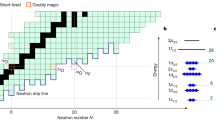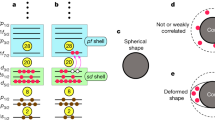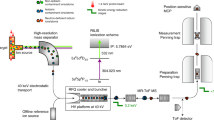Abstract
When a heavy atomic nucleus splits (fission), the resulting fragments are observed to emerge spinning1; this phenomenon has been a mystery in nuclear physics for over 40 years2,3. The internal generation of typically six or seven units of angular momentum in each fragment is particularly puzzling for systems that start with zero, or almost zero, spin. There are currently no experimental observations that enable decisive discrimination between the many competing theories for the mechanism that generates the angular momentum4,5,6,7,8,9,10,11,12. Nevertheless, the consensus is that excitation of collective vibrational modes generates the intrinsic spin before the nucleus splits (pre-scission). Here we show that there is no significant correlation between the spins of the fragment partners, which leads us to conclude that angular momentum in fission is actually generated after the nucleus splits (post-scission). We present comprehensive data showing that the average spin is strongly mass-dependent, varying in saw-tooth distributions. We observe no notable dependence of fragment spin on the mass or charge of the partner nucleus, confirming the uncorrelated post-scission nature of the spin mechanism. To explain these observations, we propose that the collective motion of nucleons in the ruptured neck of the fissioning system generates two independent torques, analogous to the snapping of an elastic band. A parameterization based on occupation of angular momentum states according to statistical theory describes the full range of experimental data well. This insight into the role of spin in nuclear fission is not only important for the fundamental understanding and theoretical description of fission, but also has consequences for the γ-ray heating problem in nuclear reactors13,14, for the study of the structure of neutron-rich isotopes15,16, and for the synthesis and stability of super-heavy elements17,18.
This is a preview of subscription content, access via your institution
Access options
Access Nature and 54 other Nature Portfolio journals
Get Nature+, our best-value online-access subscription
$29.99 / 30 days
cancel any time
Subscribe to this journal
Receive 51 print issues and online access
$199.00 per year
only $3.90 per issue
Buy this article
- Purchase on SpringerLink
- Instant access to full article PDF
Prices may be subject to local taxes which are calculated during checkout




Similar content being viewed by others
Data availability
All data from which the conclusions of this paper are drawn are contained within this manuscript. All other data can be made available on reasonable request. The large quantities of raw data (approximately 120 Tb) are shared within the ν-Ball Collaboration on servers at the CNRS-IN2P3 Centre de Calcul in Lyon (https://cc.in2p3.fr). The ALTO facility of the IJC Laboratory has a transparent data management policy that complies with the relevant European directives on open data (https://ec.europa.eu/digital-single-market/en/european-legislation-reuse-public-sector-information). Raw data from the ν-Ball Collaboration will be made publicly available after a period of 5 years. Source data are provided with this paper.
Code availability
All codes used in the data analysis can be made available on reasonable request.
References
Wilhelmy, J. B., Cheifetz, E., Zared, R. C., Thompson, S. G. & Bowman, H. R. Angular momentum of primary products formed in the spontaneous fission of 252Cf. Phys. Rev. C 5, 2041 (1972).
Schmidt, K.-H. & Jurado, B. Review on the progress in nuclear fission—experimental methods and theoretical descriptions. Rep. Prog. Phys. 81, 10630 (2018).
Andreyev, A. N., Nishio, K. & Schmidt, K.-H. Nuclear fission: a review of experimental advances and phenomenology. Rep. Prog. Phys. 81, 016301 (2018).
Rasmussen, J. O., Nörenberg, W. & Mang, H. J. A model for calculating the angular momentum distribution of fission fragments. Nucl. Phys. A 136, 465 (1969).
Moretto, L. G. & Peaslee, G. F. & Wozniak, G. J. Angular-momentum-bearing modes in fission. Nucl. Phys. A 502, 453 (1989).
Mişicu, S., Săndulescu, A., Ter-Akopian, G. M. & Greiner, W. Angular momenta of even-even fragments in the neutronless fission of 252Cf. Phys. Rev. C 60, 034613 (1999).
Shneidman, T. M. et al. Role of bending mode in generation of angular momentum of fission fragments. Phys. Rev. C 65, 064302 (2002).
Gönnenwein, F., Tsekhanovich, I. & Rubchenya, V. Angular momentum of near-spherical fission fragments. Int. J. Mod. Phys. E 16, 410−424 (2007).
Bonneau, L., Quentin, P. & Mikhailov, A. N. Scission configurations and their implication in fission-fragment angular momenta. Phys. Rev. C 75, 064313 (2007).
Hoffman, M. M. Directional correlation of fission fragments and prompt gamma rays associated with thermal neutron fission. Phys. Rev. 133, B714 (1964).
Mikhailov, I. N. & Quentin, P. On the spin of fission fragments, an orientation pumping mechanism. Phys. Lett. B 462, 7 (1999).
Bertsch, G. F., Kawano, T. & Robledo, L. M. Angular momentum of fission fragments. Phys. Rev. C 99, 034603 (2019).
Rimpault, G. et al. Needs of accurate prompt and delayed γ-spectrum and multiplicity for nuclear reactor designs. Phys. Proc. 31, 3–12 (2012).
Lemaire, M., Vaglio-Guadard, C., Lyoussi, A. & Reynard-Carette, C. For a better estimation of gamma heating in nuclear material-testing reactors and associated devices: status and work plan from calculation methods to nuclear data. J. Nucl. Sci. Technol. 52, 9 (2015).
Dudouet, J. et al. 96Kr–low-Z boundary of the island of deformation at N=60. Phys. Rev. Lett. 118, 162501 (2017).
Ha, J. et al. Shape evolution of neutron-rich 106,108,110Mo isotopes in the triaxial degree of freedom. Phys. Rev. C 101, 044311 (2020).
Zagrebaev, V. I., Aritomo, Y., Itkis, M. G., Oganessian, Yu. Ts. & Ohta, M. Synthesis of superheavy nuclei: how accurately can we describe it and calculate the cross sections? Phys. Rev. C 65, 014607 (2001).
Itkis, M. G., Vardaci, E., Itkis, I. M., Knyazhev, G. N. & Kozulin, E. M. Fusion and fission of heavy and superheavy nuclei (experiment). Nucl. Phys. A 944, 204−237 (2015).
Talou, P. et al. Late-time emission of prompt fission γ rays. Phys. Rev. C 94, 064613 (2016).
Armbruster, P., Labus, H. & Reichelt, K. Investigation on the primary spins of the 235U fission fragments. Z. Naturforsch. 26a, 512−522 (1971).
Pleasonton, F. Prompt γ-rays emitted in the thermal-neutron induced fission of 233U and 239Pu. Nucl. Phys. A 213, 413−425 (1973).
Glässel, P., Schmid-Fabian, R. & Schwalm, D. 252Cf fission revisited—new insights into the fission process. Nucl. Phys. A 502, 315−324 (1989).
Naik, H., Dange, S. P. & Singh, R. J. Angular momentum of fission fragments in low energy fission of actinides. Phys. Rev. C 71, 014304 (2005).
Abdelrahman, Y. et al. Average spins of primary fission fragments. Phys. Lett. B 199, 504−508 (1987).
Boutoux, G. et al. Study of the surrogate-reaction method applied to neutron-induced capture cross sections. Phys. Lett. B 712, 319−325 (2012).
Lebois, M. et al. Development of a kinematically focused neutron source with the p(7Li,n)7Be inverse reaction. Nucl. Instrum. Meth. Phys. Res. A 735, 145−151 (2014).
Wilson, J. N. et al. The LICORNE neutron source and measurements of prompt γ-rays emitted in fission. Phys. Proc. 64, 107−113 (2015).
Lebois, M. et al. The ν-ball spectrometer. Nucl. Instrum. Meth. Phys. Res. A 960, 163580 (2020).
Gaudefroy, L. et al. Impact of Coriolis mixing on a two-quasi-neutron isomer in 164Gd and other N=100 isotones. Phys. Rev. C 97, 064317 (2018).
Brosa, U., Grossmann, S. & Müller, A. Nuclear scission. Phys. Rep. 197, 167−262 (1990).
Franke-Arnold, S., Barnett, S. M., Leach, J., Courtial, J. & Padgett, M. Uncertainty principle for angular position and angular momentum. New J. Phys. 6, 103 (2004).
Terrell, J. Neutron yields from individual fission fragments. Phys. Rev. 128, 2925 (1962).
Göök, A., Hambsch, F. & Vidali, M. Prompt neutron multiplicity in correlation with fragments from spontaneous fission of 252Cf. Phys. Rev. C 90, 064611 (2014).
Bethe, H. A. An attempt to calculate the number of energy levels of a heavy nucleus. Phys. Rev. 50, 332 (1936).
Oberstedt, A. et al. Improved values for the characteristics of prompt-fission γ-ray spectra from the reaction 235U(nth,f). Phys. Rev. C 87, 051602(R) (2013).
Chyzh, A. et al. Systematics of prompt γ-ray emission in fission. Phys. Rev. C 87, 034620 (2013).
Qi, L. et al. Statistical study of the prompt-fission γ-ray spectrum for 238U(n, f) in the fast-neutron region. Phys. Rev. C 98, 014612 (2018).
Valentine, T. E. Evaluation of Prompt Fission Gamma Rays for Use in Simulating Nuclear Safeguard Measurements. Oak Ridge National Laboratory Report TM-1999/300, https://www.osti.gov/servlets/purl/753485-4TSmOw/webviewable/ (US Department of Energy Office of Scientific and Technical Information, 2001).
Flynn, K. F. et al. Distribution of mass in the spontaneous fission of 256Fm. Phys. Rev. C 5, 1725 (1972).
Andreyev, A. et al. New type of asymmetric fission in proton-rich nuclei. Phys. Rev. Lett. 105, 252502 (2010).
Etasse, D. et al. Fast Acquisition System for nuclEar Research (FASTER); http://faster.in2p3.fr (2013).
Hamilton, J. et al. New insights from studies of spontaneous fission with large detector arrays. Prog. Part. Nucl. Phys. 35, 635 (1995).
Smith, A. G. et al. Spectroscopy of neutron-rich nuclei populated in the spontaneous fission of 252Cf and 248Cm. AIP Conf. Proc. 481, 283 (1999).
Agostinelli, S. et al. GEANT IV—a simulation toolkit. Nucl. Instrum. Meth. Phys. Res. A 506, 250−303 (2003).
Radford, D. C. ESCL8R and LEVIT8R: software for interactive graphical analysis of HPGe coincidence data sets. Nucl. Instrum. Meth. Phys. Res. A 361, 297-305 (1995).
Tuli, J. K. Evaluated nuclear structure data file. Nucl. Instrum. Meth. Phys. Res. A 369, 506-510 (1996).
Wilson, J. N. et al. Anomalies in the charge yields of fission fragments from the 238U(n,f) reaction. Phys. Rev. Lett. 118, 222501 (2017).
Pühlhofer, F. On the interpretation of evaporation residue mass distributions in heavy-ion induced fusion reactions. Nucl. Phys. A 280, 267−284 (1977).
Weizsäcker, C. F. Zur Theorie der Kernmassen. Z. Phys. 96, 431–458 (1935).
Kirsch, L. E. & Bernstein, L. A. RAINIER: a simulation tool for distributions of excited nuclear states and cascade fluctuations. Nucl. Instrum. Meth. Phys. Res. A 892, 30−40 (2018).
England, T. R. & Rider, B. F. Evaluation and Compilation of Fission Product Yields. Los Alamos Report LA-UR-94-3106, ENDF-349, https://www-nds.iaea.org/endf349/ (International Atomic Energy Agency Nuclear Data Services, 1993).
Acknowledgements
We thank the staff of the ALTO facility of the IJC Laboratory, Orsay, for providing the intense, precisely focused 7Li primary beams for very long periods, thus permitting the collection of large datasets with the ν-Ball spectrometer. We thank W. Nazerewicz, S. Åberg and O. Serot for discussions of fission theory; we also thank S. Åberg and O. Serot for assistance with the theoretical interpretation of our experimental results. We thank G. Kessedijan for assistance with variance−covariance calculations. Finally, we thank the Gammapool international consortium for the loan of the germanium clover detectors used to construct the spectrometer. This work was supported by the IN2P3/CNRS, France, the STFC UK Nuclear Data Network, the STFC (grants ST/L005743/1 and ST/P005314) (PHR), the Marion Redfearn Trust (RCL). P.H.R., M.B., A. Boso and P.I. acknowledge support from the UK Department of Business, Energy and Industrial Strategy (BEIS) via the National Measurement System. P.K., P.-A.S. and J.W. acknowledge the support from BMBF under grant NuSTAR.DA 05P15RDFN1. Funding from the HORIZON2020 programme of the European Commission is acknowledged for Transnational Access to the ALTO facility under the Integrated Infrastructure Initiative, European Nuclear Science and Applications Research 2 (ENSAR2), grant agreement number 654002. A. Blazhev, R.-B.G. and N.W. acknowledge support by the German Research Foundation (DFG grant BL 1513/1-1). L.F., V.V., J.B. and V.S.-T. acknowledge funding from the Spanish MINECO via FPA2015-65035-P and RTI2018-098868-B-I00. A.A. acknowledges funding Spanish MINECO via FPA2017-83946-C2-1-P and Ministerio de Ciencia e Innovacion grant PID2019-104714GB-C21. B.F. acknowledges funding from the Polish National Science Centre under contracts 2014/14/M/ST2/00738 and 2013/08/M/ST2/00257. M.P. acknowledges funding from the Polish National Science Centre under contracts UMO-2019/33/N/ST2/03023, UMO-2020/36/T/ST2/00547 and A.K., K.M. and E.A. under contract UMO-2015/18/E/ST2/00217. D.G. acknowledges funding from the Norges Forskningsråd (Research Council of Norway) 263030. S.L., G.B., C.P., S.Z., L.W.I, A.G. and S.B. acknowledge funding from the Italian Istituto Nazionale di Fisica Nucleare (INFN).
Author information
Authors and Affiliations
Contributions
J.N.W. participated in the construction of the ν-Ball spectrometer, contributed to the experimental data taking, organised the ν-Ball international collaboration, performed the analysis work presented here and wrote the main body of the paper. D.G. helped with experimental and theoretical discussions, interpretation of results, manuscript preparation and resubmissions, calculations, plots and bibliography. D.T. constructed the spectrometer, calibrated and optimized the spectrometer, kept the spectrometer running, contributed to the experimental data taking, performed data processing of the large quantities of triggerless data and helped distribute it to the collaboration. M.L. organized the ν-Ball project, led the construction of the spectrometer, organised the experimental campaign, kept the spectrometer running, contributed to the experimental data taking and measured ν-Ball performances. M.R., N.J., R.C., G.H., R.L. and R.-B.G. helped with the cabling of the ν-Ball spectrometer, supported the running of the spectrometer (filling with liquid nitrogen, monitoring detectors, and so on), calibrated and optimized the spectrometer, contributed to the experimental data taking and performed offline data analysis. D.E. developed and helped deploy the digital electronics used for the ν-Ball Data Acquisition System). L.G. developed and deployed the 252Cf ionization chamber. S.O., C.S., T.K., P.H.R., A. Blazhev, N.W., S.L., B.F., A.A., M.F., L.F. and others contributed to the theoretical discussions and interpretation of results. S.S. helped with organization, discussions and interpretation, bibliography and manuscript preparation. F.Z. carried out fragment decay simulations using the RAINIER code. All listed collaborators helped keep the experiment, the spectrometer and the data acquisition systems running over the period of 7 weeks during which the data were collected.
Corresponding author
Ethics declarations
Competing interests
The authors declare no competing interests.
Additional information
Peer review information Nature thanks Cedric Simenel, Patrick Talou and the other, anonymous, reviewer(s) for their contribution to the peer review of this work. Peer reviewer reports are available.
Publisher’s note Springer Nature remains neutral with regard to jurisdictional claims in published maps and institutional affiliations.
Extended data figures and tables
Extended Data Fig. 1 γ-ray coincidence spectra for 140Xe.
Spectra are gated by the 2+→0+ transition for the three different fissioning systems studied in this work. The spins of states emitting the yrast sequence of transitions are marked. Strong γ-rays from the binary partner fragments are indicated. γ-rays from fragment partners in 252Cf(SF), such as 112Ru, were detected in flight and are thus not visible owing to Doppler broadening. The 252Cf(SF) spectrum has many fewer counts, but similar experimental sensitivity is achieved owing to the elimination of backgrounds from other processes by direct detection of the fission fragment in the ionization chamber with the γ−γ coincidences.
Extended Data Fig. 2 Coincident γ-ray spectra from the 238U(n, f) reaction gated on transitions from 140Xe emitted from states of increasing spin.
The fits to transitions decaying out of specific states of the partner nucleus 96Sr are shown in red. The 492-keV transition from the 6+ state in 96Sr in the third panel is deduced from its neighbours rather than fitted, owing to contamination. The intensity pattern is not observed to vary and the average spins in 96Sr show no notable changes. The relationships between partner spins for several more nuclei are shown in Fig. 2.
Extended Data Fig. 3 Monte Carlo simulations of events with correlated spins at scission.
Placing conditions on the minimum spin at yrast of events in fragment 2 affects the yrast distributions of event spins in fragment 1.
Extended Data Fig. 4 Examples of experimental spin distributions for a range of nuclei observed in the 238U(n, f) reaction.
Statistical uncertainties are shown. To eliminate the odd−even staggering effect and facilitate easy visualization, side-feedings of odd spins are redistributed equally between the two neighbouring even spins. The red curves are fits to the experimental data with one free parameter and are used to extract 0+ side-feedings via an iterative procedure
Supplementary information
Rights and permissions
About this article
Cite this article
Wilson, J.N., Thisse, D., Lebois, M. et al. Angular momentum generation in nuclear fission. Nature 590, 566–570 (2021). https://doi.org/10.1038/s41586-021-03304-w
Received:
Accepted:
Published:
Issue Date:
DOI: https://doi.org/10.1038/s41586-021-03304-w
This article is cited by
-
Gamma-ray spectroscopy of fission fragments with state-of-the-art techniques
La Rivista del Nuovo Cimento (2022)
Comments
By submitting a comment you agree to abide by our Terms and Community Guidelines. If you find something abusive or that does not comply with our terms or guidelines please flag it as inappropriate.



